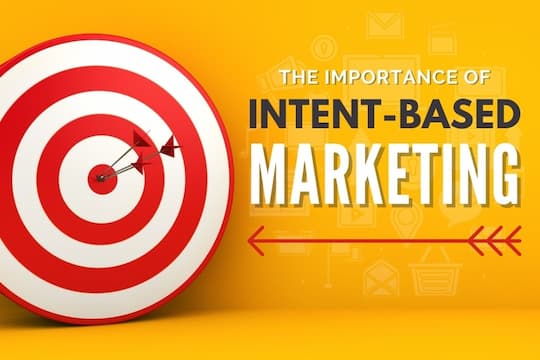
As a small business, one of your most powerful tools for attracting more customers to your company is your marketing strategy. A robust approach enables you to expand your target audience, boost sales of your products or services, and gain a deeper understanding of what your customers are interested in. However, you can't develop an effective marketing campaign without gathering the right data for your needs.
This is the subject of our article. Intent-based marketing is grounded in data that illuminate the behavior and interests of your target audience. With help from this data, you can make smarter decisions when forming your marketing strategy and ensure that it gets you results. Here's everything you need to know about intent-based marketing and how you can use it to grow your small business.

The days of ‘spray and pray’ marketing are over! You need to understand your audience if you want to get the best ROI for your marketing dollars.
Intent-based marketing describes the act of tailoring marketing campaigns to the needs of customers with specific intentions. It helps to take the guessing game out of the equation. By analyzing these consumers’ online behavior and other factors, intent-based marketers determine their choices and use this information to cater to their offering to customers' tastes.
More specifically, intent-based data gives you an idea of why your prospects are browsing online. Where are they on their customer journey? Are they researching, or are they ready to buy? What do you need to do to get in front of them?
Before you even begin to think about intent, you need to have analytics installed on your website. More than that, though, you need to make sure that you have some time dedicated to analysis. This is not a set it and forget it deal. Having the analytics on your site will allow you to glean more in-depth insights from your users.
When you are checking your analytics, make sure you understand that their observed behaviors are on your website. That means that they are a smaller sample size than the whole of your market. The observation should be used as guidance and not matter-of-fact. It pays to stay up to date with your industry as a whole to validate some of the findings on your site to see if they are more global.

The key to intent marketing is figuring out who the people on your website are and why they are there. Context is king here. Are they in dire need of something, or are they merely researching? There are so many things that you could look for. What stage in the buyer’s journey are they in? Are they ready to buy? What evidence is there to support this hunch? That is where your data comes into play.
It's essential to know how to sift through this information so you can make the most of it. When analyzing your data, be sure to focus on these two main types of information.
The first essential type of data is categorized as individual activity data, and it allows businesses to gain insight into the way individual customers interact with their website. Some examples of these characteristics include the following:
Some individual activity data will help you better understand which types of people make up your target audience. For example, do you have a larger group of returning visitors or first-time visitors viewing your page? Breaking down this type of data will make it significantly easier for you to decide how to proceed.
The second type of intent-based marketing data to focus on is grouping deep behavioral data. This category delves further into the behaviors that users engage in when they visit your website.
One of the most important benefits of deep behavioral data is its ability to shed light on your audience’s current interests. Some of the main pieces of information included in deep behavioral data are dwell time, page scrolls, clicks, and hovers. Why did this cluster of users dwell on this page longer? What caused them to click on some aspects of the page? How does it tie in with the activity data? Are there patterns?
You can use this data to your advantage in many different ways. In terms of dwell time, you can analyze your customers’ average amount of time on your website to determine what type of content is holding their attention. After doing this analysis, can you tell what your customers are looking for?

Once you have had time to sift through the data, you can start seeing trends. What search terms signal more intent to buy? What are the common SEO mistakes to avoid? Can they be clustered in any way, such as by demographics? If there is a high volume term/page higher in the funnel? Can it be leveraged in any way to get more conversions? This is where strategy formation starts to take shape.
What things do you need to do to cater to intent? Do you need to target long-tail search terms, change your content strategy, or is it your website? Do you need to implement a lead scoring system to validate your findings?
Once you have a direction, you can use it to guide you on your different marketing channels. Most social media channels have audiences that you can target with your messaging within their respective interfaces. LinkedIn and Facebook tend to have more robust social targeting. Google Ads and Bing Advertising both have audience targeting as well. You just need to know what audience you are targeting.
Intent-based marketing is challenging, but it is worth it. You have to learn to put your bias aside and just follow the data. You need to understand that your buyer might not be who you think it is, or it could be more groups than you might think. You have to be able to adapt and evolve it over time. If you create the personas for the different stages of your buyer’s cycle change, you need to pivot quickly.
You have to ensure that the data that you are using is of good quality. If your analytics implementation is not right, your basis for decision making will not be sound either. Partnering with an external data partner is a great idea, but it brings its challenges as well.

Intent-based marketing, on the other hand, is specifically built to help business owners analyze active demand. As a result, you can connect with what motivates your customers in the present moment and tailor your content to these motivations.
Additionally, analyzing intent data helps put you ahead of your competitors. If you know why your users are there, you have an advantage. Most marketers end up wasting too much time on the initial awareness stage when developing a marketing approach. With intent-based data, however, you automatically skip the awareness stage and move on to the process of making important decisions. This helps make your marketing process more efficient.
Small businesses need to work extra hard to attract more customers and give them a compelling reason to trust their products and services. Once you're ready to start using intent-based online marketing to grow your small business, you can make use of our highly-rated services to ensure that your company reaches the next level.
Intent-based marketing is the practice of tailoring campaigns to prospects based on real-time signals about their goals, interests, and stage in the buyer journey. It uses behavioral and search data to show the right message at the moment a customer shows purchase intent.
Traditional marketing often broadcasts broadly and hopes to catch interest, while intent-based marketing studies online behavior to identify who is researching or ready to buy. This focus lets you skip generic awareness messaging, spend budget efficiently, and produce content that speaks directly to active demand.
Key data falls into two buckets: individual activity data, such as pages viewed, search terms, and purchases; and deep behavioral data, like dwell time, scroll depth, clicks, and hovers. Together these signals reveal who visitors are, what they want, and how close they are to buying.
Start by installing reliable analytics, then dedicate time to reviewing reports. Identify patterns in search terms, high-intent pages, and engagement metrics. Build audience segments, create content or ads that match their needs, and use platforms like Google Ads, LinkedIn, or Facebook to target those segments precisely.
Common hurdles include biased assumptions that override data, poor analytics implementation, small on-site sample sizes, and the need to adapt personas as behavior shifts. Partnering with external data providers can help, but you must still validate quality and stay flexible as insights evolve.